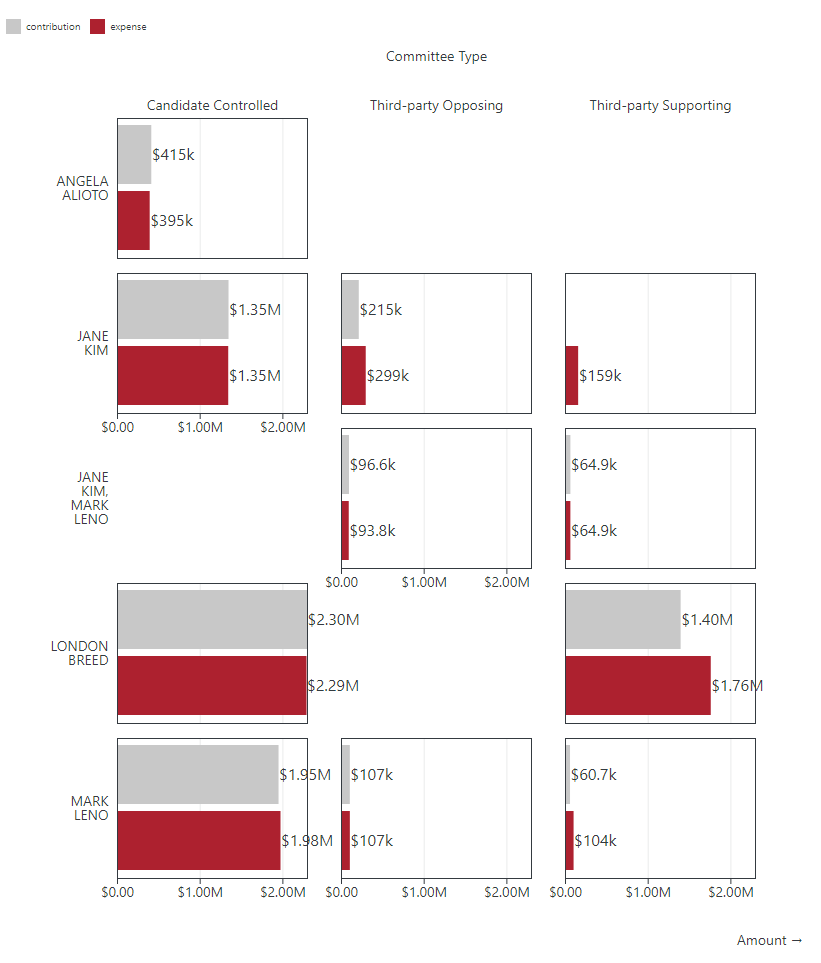Beginning with the election of March 2024, the Ethics Commission is presenting an abbreviated version of the campaign finance dashboards which visualize disclosures in local San Francisco elections.
These Daily Digest Dashboards present up-to-date summary totals for contributions and expenditures for both candidate and ballot measure campaign committees. Candidate contests are presented grouped by candidate name and subdivided by candidate controlled, third-party supportive, and third-party oppositional funds. Ballot Measure contests are presented by funds in support and funds opposed. The totals incorporate the latest scheduled and late-period filings, taking into account the current date so as not to double-count.
One of the key features of the Daily Digest is that, unlike the full-featured campaign dashboards, these charts update without daily manual action by staff. The data behind each chart is updated automatically each night during a pre-election period and therefore reflect the most current values for reported fundraising and spending by committees. The date of the last update is shown in a caption below the charts.
The dropdown select element can be used to choose the contest. Candidate and Ballot Measure contests are both listed.

Choosing a candidate contest draws a grid of horizontal bar charts. Candidates are shown in rows, labeled on the left with the candidate (or candidates) name. Committee types are shown in columns, labeled on the top as Candidate Controlled, Third-party Opposing, or Third-party Supporting.
The subcharts in the Candidate Controlled column contain bars representing total contributions and total expenses reported by the candidate controlled committee. Total contributions include monetary contributions, non-monetary contributions, loans, miscellaneous increases to cash, and funds reported on a late period report (since the most recent filing deadline.) Total expenses include payments made, repayments on loans, unpaid bills, and expenses reported on a late period report (since the most recent filing deadline.)
If a contest includes activity by third parties, contributions and expenses are summed across committees and shown under the appropriate “opposing” or “supporting” column.
If no third-party committee has reported supportive or opposing funds for a given candidate, no chart appears in that column.
A third-party column will only show contributions if a primarily formed committee has formed and reported activity, but all third-party spending, including independent expenditures and contributions made to a primarily formed committee will show up under “expenses”.

The chart above shows the four major candidates for mayor in the June 2018 election, combining eleven primarily formed committees and independent expenditures by at least ten general purpose committees. These include the four candidate-controlled committees; two third-party in support of London Breed; one opposed to Jane Kim; one in support and one opposed to Mark Leno; one third-party committee in support of both Jane Kim and Mark Leno; and one opposed to both Jane Kim and Mark Leno. Thus the “Third-party Supporting” column in the row for London Breed shows reported funds from two committees totaled together, as well as any independent expenditures by general purpose committees. The contributions bar in the Third-party Supporting column of Jane Kim’s row is blank because there was only third-party independent expenditure spending by general purpose committees and no primarily formed committee.

The preceding chart shows a contest with three candidates and third-party spending in support of two candidates. The column for oppositional spending does not appear, and no sub-chart is drawn in the third-party supporting column for the third candidate.

The chart above shows a Ballot Measure contest which has both supporting and opposing proponents.

The chart above shows a Ballot Measure contest which has only supporting proponents.